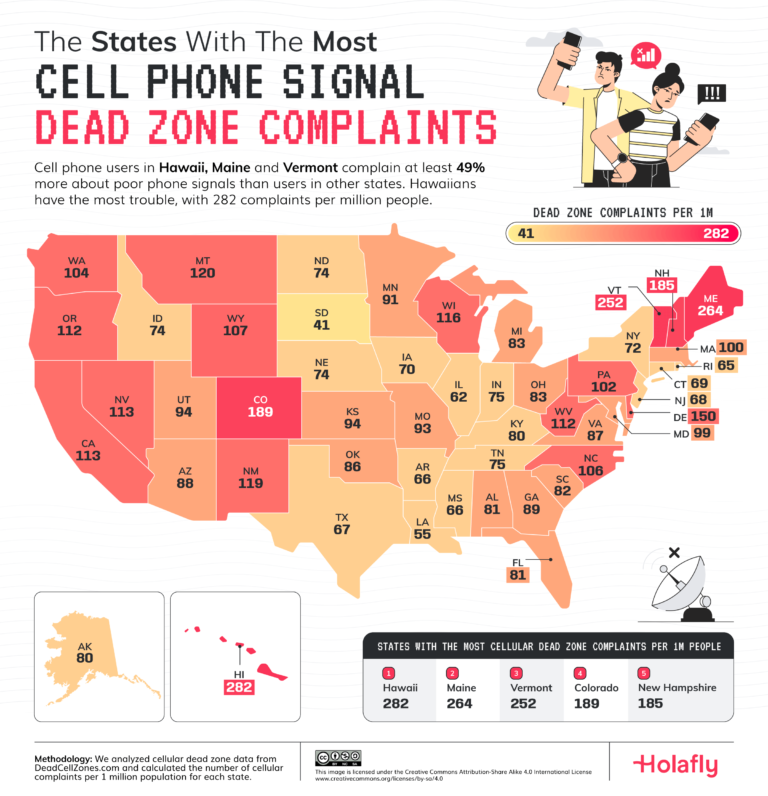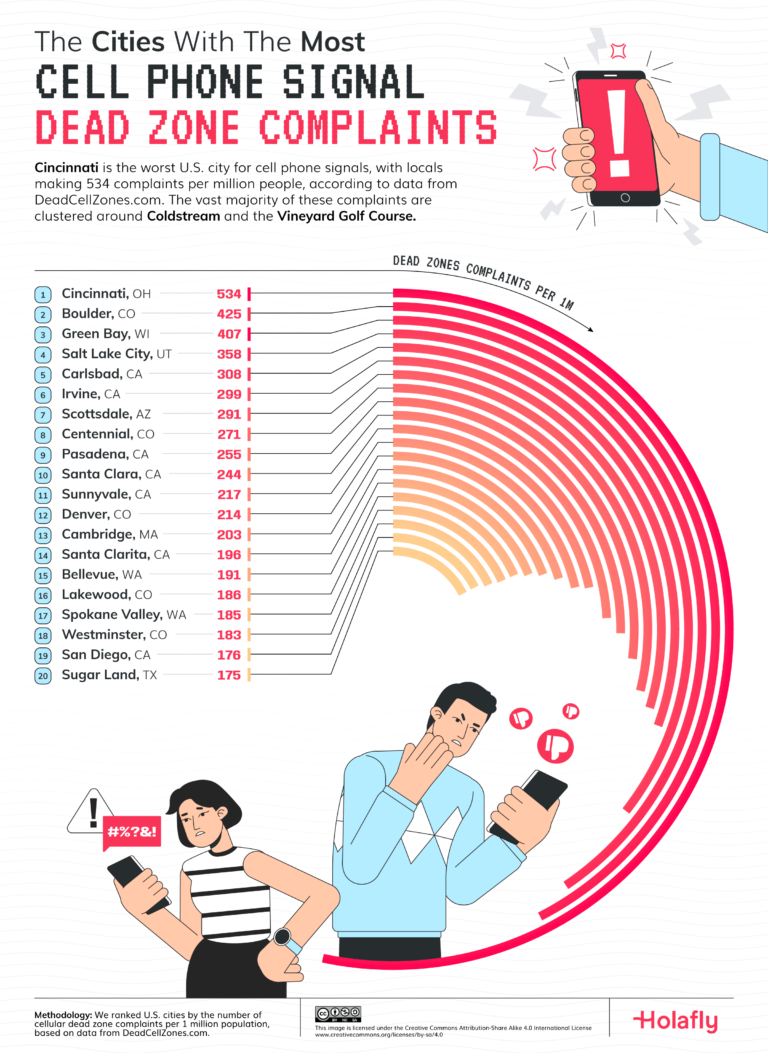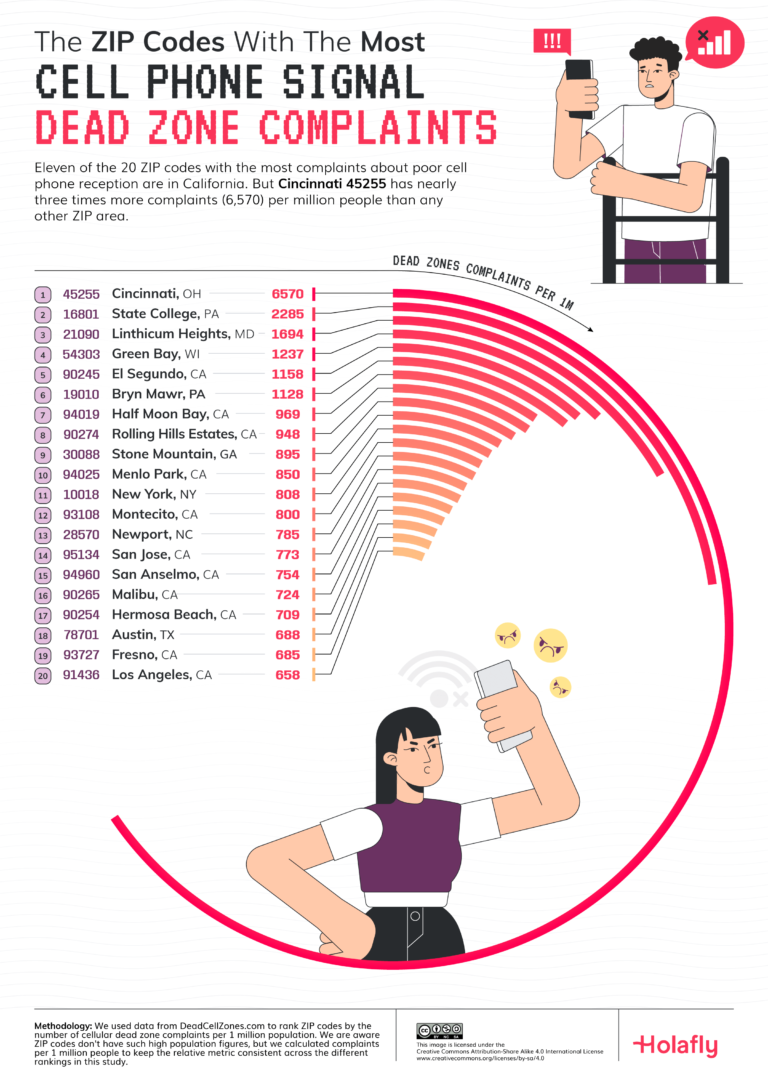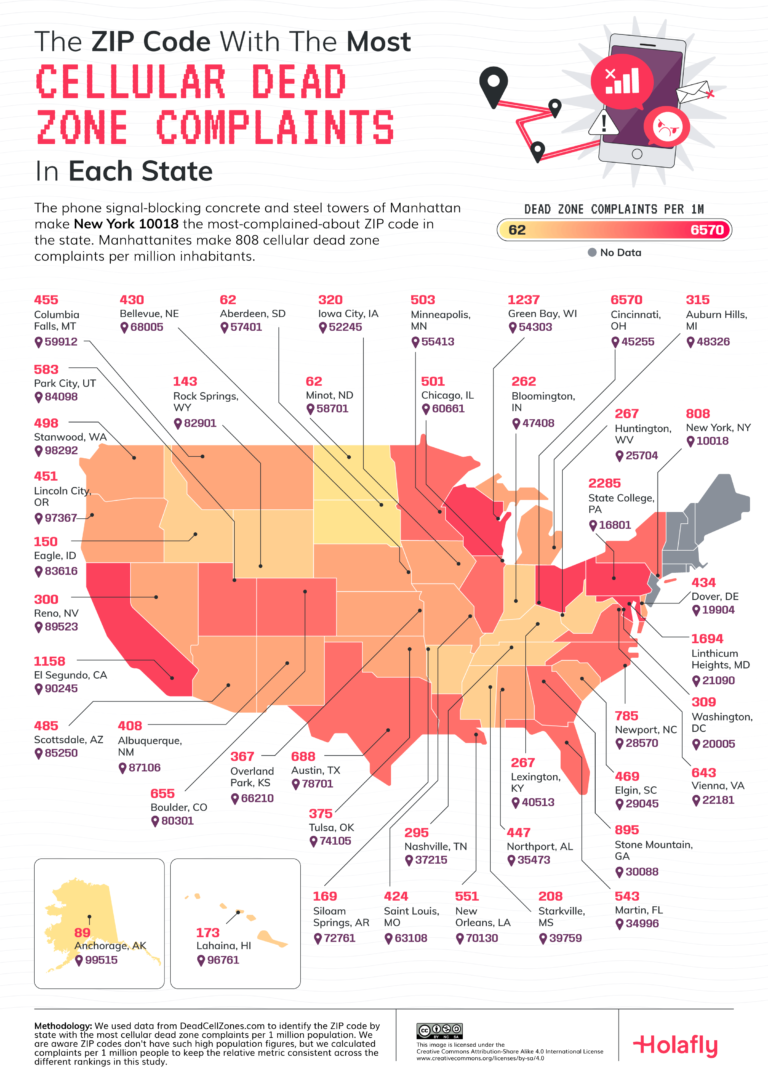The U.S. Cities with the Most Cell Signal Dead Zone Complaints
Tall buildings, and extreme weather conditions can block signals, creating ongoing or regular dead zones. But which places are the worst?
America is dotted with over 153,400 purpose-built cell towers, and well over a million smaller nodes relay mobile phone signals into — you might imagine — every last corner of the U.S. But despite the expanding network, complaints of dropped calls and intermittent connections reached a recent high in 2023, with over one in ten calls proving problematic.
The number of problem calls has fallen again in 2024, thanks to new 5G phones and network technology. However, even areas close to cell towers can prove sketchy if demand is high.
There is a limit to how many phones a fixed wedge of radio wave frequency can serve. That’s one reason telecom firms are anxious to build more towers and buy more frequency space. “Now we are able to take that two-lane highway and make it a 20 lane,” said Verizon spokesperson Andrew Testa of one such upgrade in 2023.
Tall buildings, extreme weather conditions and wildfire smoke can block signals, creating ongoing or regular dead zones — which explains why so many phone issues seem tied to particular spots or neighborhoods. But which places are consistently the worst for cell reception? The Holafly Research Team conducted a deep dive into consumer complaint data from DeadCellZones.com to identify these areas and help you avoid unpleasant surprises.
Key Findings
- Hawaii is the state with the most cell signal dead zone complaints: 282 per million people.
- The state with the least cell signal complaints is South Dakota (41 per million people).
- In Cincinnati, Ohio, there are 534 cell signal dead zone complaints per million people, the most of any city.
Hawaii Has the Most Complaints About Dead Zones
First, we mapped the states with the most complaints about Cell Signal Dead Zones per million people. Hawaii (282 per million), Maine (264) and Vermont (252) have significantly more complaints than other states.
In York, Maine,, the summer influx of tourists strains a system that locals already feel is lacking. “It creates this saturation effect where in certain areas you can’t even send a text message or a phone call,” local IT manager Alex Gagnon told Seacoastonline. The city has now agreed to have streetlight small cells installed around town in lieu of the towers that residents have fought to keep out.

Of course, not every dead zone report may be a complaint. “I don’t care if I have reception,” Kauai resident John Sargent told Civil Beat. “In fact, I don’t actually want it.” Sargent’s community recently came together to protest AT&T’s plans to install a cell tower on the island.
“A number of Hawaiian families who go back 10 generations live out here,” says local lawyer Terri Tico. “The ocean is their refrigerator, the coral is their garden and they take care of it. They’re very aligned with the land and the sea and they want to protect it. They don’t necessarily want it modernized. So to put in a tower that is 100 feet higher than any other building out here is just absurd.”
Cincinnati is America’s Capital of Cell Signal Dead Zones
There are seven California cities and five in Colorado among the 20 worst U.S. cities for cell signal dead zones. But the worst, by a leap of 26% over the second-worst, is Cincinnati, Ohio, where there are 534 complaints per million people.
The issue in Cincinnati is particularly notable downriver from the main urban center, with the 45255 ZIP code complained about nearly three times as often as any other U.S. ZIP code. This is a picturesque area around a golf course, and anecdotally, residents of nearby neighborhoods have resisted the installation of further cell towers.

Carlsbad is California’s top city for dead zone complaints, with 308 per million people. Ironically, one local company — Viasat — is working on a solution for global dead zones by providing direct-to-device (D2D) networks. These would deliver signals straight from satellites to phones, bypassing cell towers and potentially patching cell signal dead zones in California and around the world.
Californian ZIP Codes Dominate Among Worst Spots for Cell Signal
Finally, we compared the number of complaints in each ZIP code around the U.S. The worst ZIP code, Cincinnati 45255, gets enough complaints to make Cincinnati the worst city overall (see Cincinnati is America’s Capital of Cell Signal Dead Zones, above). But 11 of the 20 worst ZIP codes are spread across one state: California.

California’s worst ZIP code for cell signal dead zones is El Segundo 90245, with 1,158 complaints per million people. Half Moon Bay 94019 is not far behind on 969 complaints. The local planning commission recently unveiled a plan to replace an existing 50-foot metal cell tower with a new 75-foot tower behind the sports field at Half Moon Bay High School — responding to local concerns that a new tower might arrive too close to residential areas or busier zones of the school.

Our final map shows each state’s worst ZIP code for cell signal dead zones. New York’s is Manhattan 10018, with 808 complaints per million inhabitants. One survey found that around 60% of Manhattan residents frequently suffer dropped calls. “It shouldn’t be like that in 2024. The whole world has stepped up, and Manhattan hasn’t, I don’t really understand,” Manhattan dogwalker Sonya Burns told the New York Post. “New York needs to get more current. You know, 2024!”
“Radio frequencies that the carriers use don’t work well with buildings. These frequencies don’t interact well with steel or concrete, which can block signals,” said Iain Gillott, a technical adviser at the Wireless Infrastructure Association. “And of course, skyscrapers in New York are built of concrete and steel.”
Breaking the Waves
The apparent worsening of cell reception around the States is partly due to the domination of cell phone communication. Not only do more people have cells, but they spend more time on them and rely on them more for activities they may have previously completed on a computer, crowding out busy networks.
Relying on the telecom companies to improve the situation can be a waiting game since they respond both to their own financial motivations and the demands — or objections — of locals when it comes to new cell towers. Instead, switching providers can help, although turning flight mode on and off can also help your phone locate a nearer cell tower when in a jam.
eSIM: A Game-Changer for Travelers in Dead Zones
New technologies, such as travel eSIM, are emerging as effective solutions for managing emergency situations, especially when options are limited. Unlike traditional SIM cards tied to specific carriers, international eSIMs offer the flexibility to automatically scan for alternative networks.
As David Incapie, Tech Leader at Holafy, explains, “The core advantage of eSIM technology lies in its ability to dynamically interact with available networks, enabling users to prioritize stronger and more reliable connections in real time. This innovation eliminates the constraints of traditional SIM cards by allowing seamless integration across multiple carriers. For travelers navigating unfamiliar terrains, this ensures uninterrupted connectivity, where even minimal signal strength can prove critical in emergencies.”
Before venturing into areas prone to dead zones, it’s a good idea to download essential resources, like offline maps and other essential apps or documents . While innovations like eSIMs offer real-time network flexibility, taking proactive measures ensures you’re fully prepared for any situation.
Methodology
We analyzed cellular dead zone data from DeadCellZones.com. First, we organized the data by state, city and ZIP code and sourced population counts for each location. Next, we calculated the number of cellular complaints per 1 million population for each location to keep the relative metric consistent across the different rankings in this study. This data analysis was completed in October 2024.





 Language
Language 


















 No results found
No results found





